Editor’s Note: This article was originally published in Overland Journal’s Fall 2020 issue.
Photography courtesy of Rebelle Rally
On day two of the Rebelle Rally, my teammate and I found ourselves unexpectedly running in eighth place, ratcheting up both pressure and expectation. With five more days of navigating our way through the desert, could we hold on? Was I bad enough at this to eventually shatter my teammate’s faith? Would there be screaming?
Day 1 – Start Line | Gold Point, Nevada
37˚ 21.227’ N; -117˚ 21.929’ W
The Rebelle Rally isn’t a race. Rather, it’s a seven-day endurance event where teams of two attempt to chisel their way over 1,500 miles of off-road terrain using nothing but a paper map and compass. And unlike most of these kinds of endeavors, the four-year-old Rebelle is strictly for women. On day one, my navigator and four-time Rebelle, Sedona, and I got turned around a few times just north of Death Valley, outside the near-ghost town of Gold Point, Nevada. Yes, it’s as splintered and hooch soaked as it sounds. We knew that wouldn’t be the only time we’d lose our way. Over the next seven days, there would be tears, panic, electric moments of triumph, and a reckoning between who we thought we were and who we actually are.
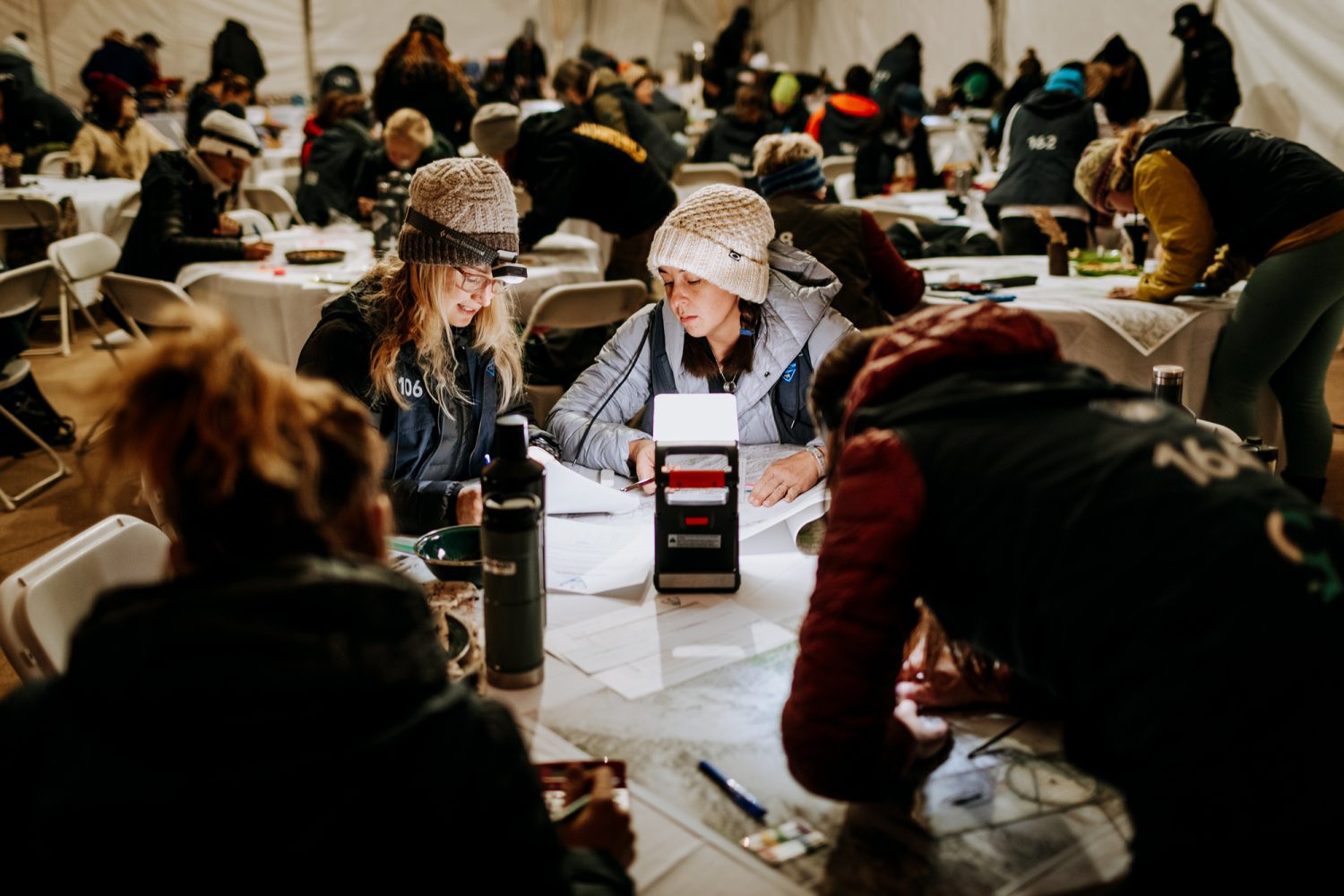

That’s because the Rebelle is hard—really hard. It isn’t just about safely getting from Lake Tahoe down to the Mexican border through some of the emptiest tracts in North America. There are a dizzying variety of tests to complete and checkpoints (CPs) to nail, each earning points for the 38 teams that pay the $6,500 per person entry fee. Any GPS-capable device, including a cell phone, is strictly forbidden for the entire week. If your truck has a navigation system built in—the competition is split into two classes for traditional 4WDs and crossovers—the organizers cover it over with cardboard and tape. There’s an entire day of practice exercises at the start just to get teams up to speed, as the unusual set of skills needed to complete this event tend to rust over during the intervening months where contestants Google Map their way around with the rest of the universe.
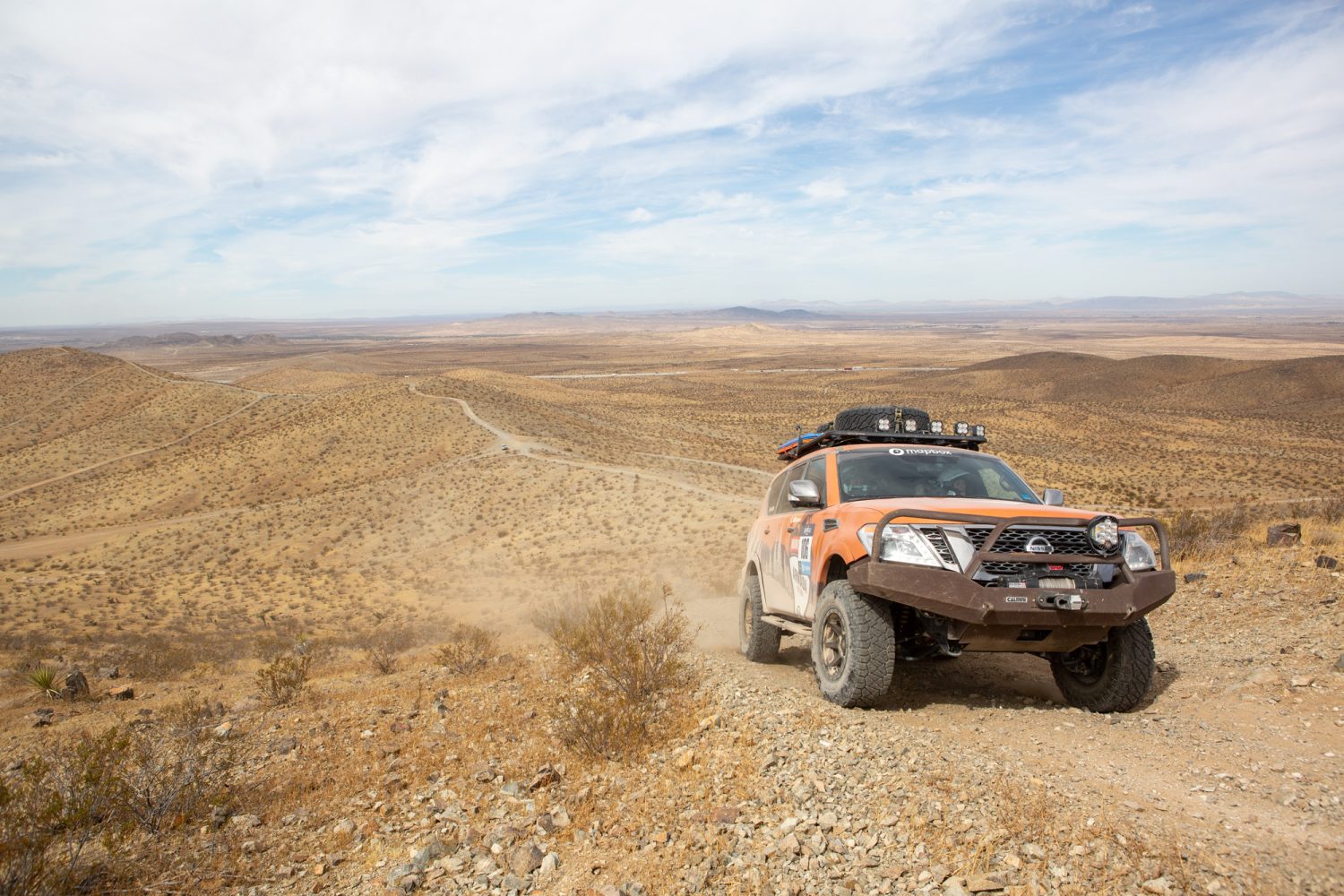
By day two, Team Wild Grace (that’s us) found our groove, the laser-focused, locked-in kind. For Sedona Blinson, our navigatress, the wavy lines of topography on our maps easily project onto the terrain out our windows like Princess Leia coming out of R2D2. “See that finger jutting out over there? Take me there,” Sedona would command, and as the driver, I would dutifully punch the throttle. The V-8 under the hood of our heavily modified 2018 Nissan Armada was tuned out to 400 horsepower, making it a highly capable home for the week.
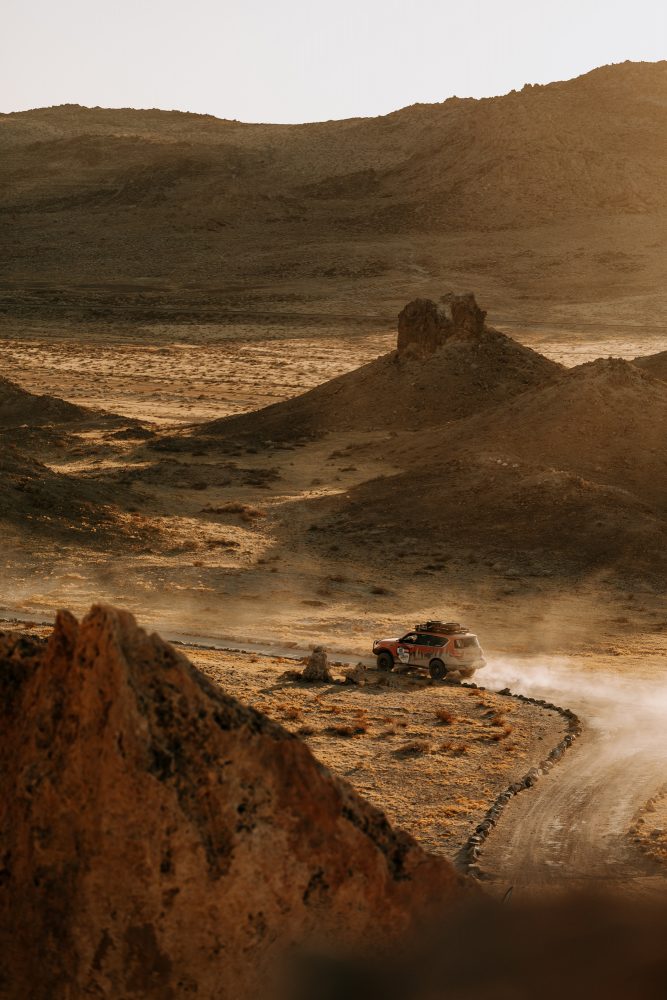
In fact, our groove was so good that by the end of day two, we were in eighth place. Which presented a serious problem because up till that moment, we had merely hoped to compete hard but have fun and maybe by the end break into the top ten, such is the level of competitiveness in this still-young event. Sedona and I met two years ago when I did my first Rebelle. With her usual teammate out with a new baby, she asked me to join her this year. Sedona’s vivacious demeanor rivals a glass of Dom Pérignon. If there were a Rebelle staff favorite award, she would unanimously win it. Of course, I said yes. Though, I am a neophyte, with just one rally under my belt that devolved into screaming at various points as my navigator and I vented our frustrations on each other with verbal sledgehammers on our way to a nearly last-place finish. Please, let there be no screaming.
Day 3 CP 18 – Green | Harrison Ranch, Landers Meadow
35° 26.744’ N; -118° 16.866’ W
Every day during the Rebelle, you go out and hunt for CPs, which are assigned point values and designated like ski runs. Greens are mandatory, and the easiest to find, marked on the terrain by fluttering flags put out by the organizers. Optional blue and black CPs are tougher; the blacks aren’t even marked, they are just a spot out in the middle of nowhere that could be a patch of creosote or a basking lizard or just another pile of endless sand. We carry rally-issued satellite trackers and ping them at all CPs. The signal hurtles into space, then bounces back to the Rebelle’s sophisticated scoring software.
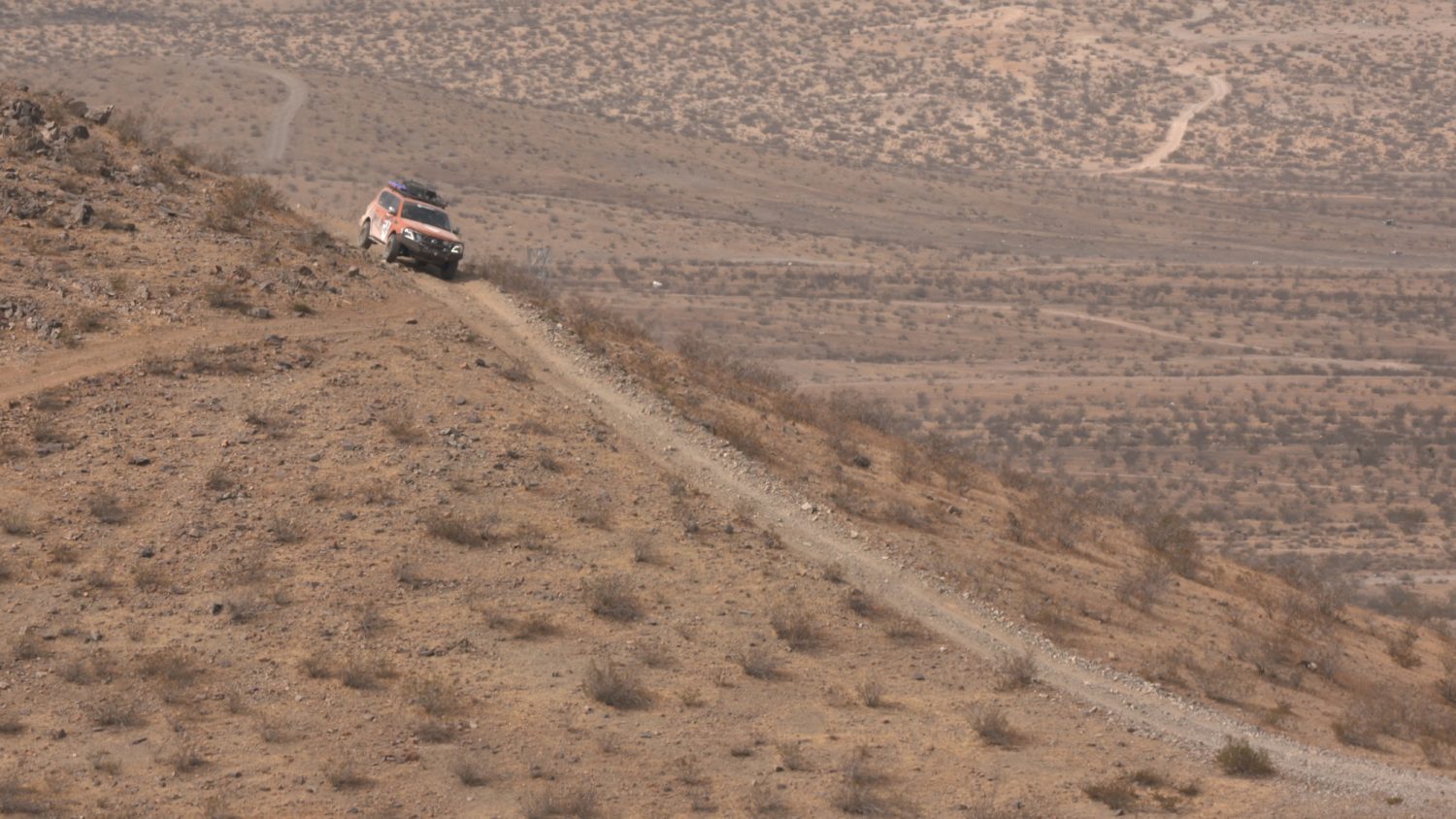
On day three, the adrenaline wears off, and the doors of whatever truck you’re driving start to close in like the walls of Death Star garbage masher No. 3263827. Last year, Sedona and her teammate had a Chernobyl-style meltdown on day three. When I asked her why, she said she couldn’t even remember. I myself got hopelessly stranded overnight in dunes with my teammate two years ago on day three. Unmentionable words were exchanged. Sedona and I decided that this year, we would simply have no day three.
And we managed to outrun the curse for a while. Leading up to the final CP, we had enjoyed a near-perfect day. We’d bumped and bounced over 90 miles of dusty roads to Ridgecrest, California, nestled between the southernmost points of Death Valley and Sequoia National Forest, then navigated past the otherworldly Trona Pinnacles, eerie spires of sandstone you might expect Spock to poke his head around. We had hit 92 percent of our CPs. At the Rebelle, that is the definition of killing it.
Making for our remote campsite, we came across Emily Miller, an off-road racer, sports marketing maven, and general badass who hatched the idea for the Rebelle years ago on her kitchen table. Full of bravado, we stopped looking at the map or the landscape around us, and mindlessly followed Emily. I hardly noticed the distance we’d traveled while Sedona munched on deli meats. We were elated that we’d avoided the day three jinx.
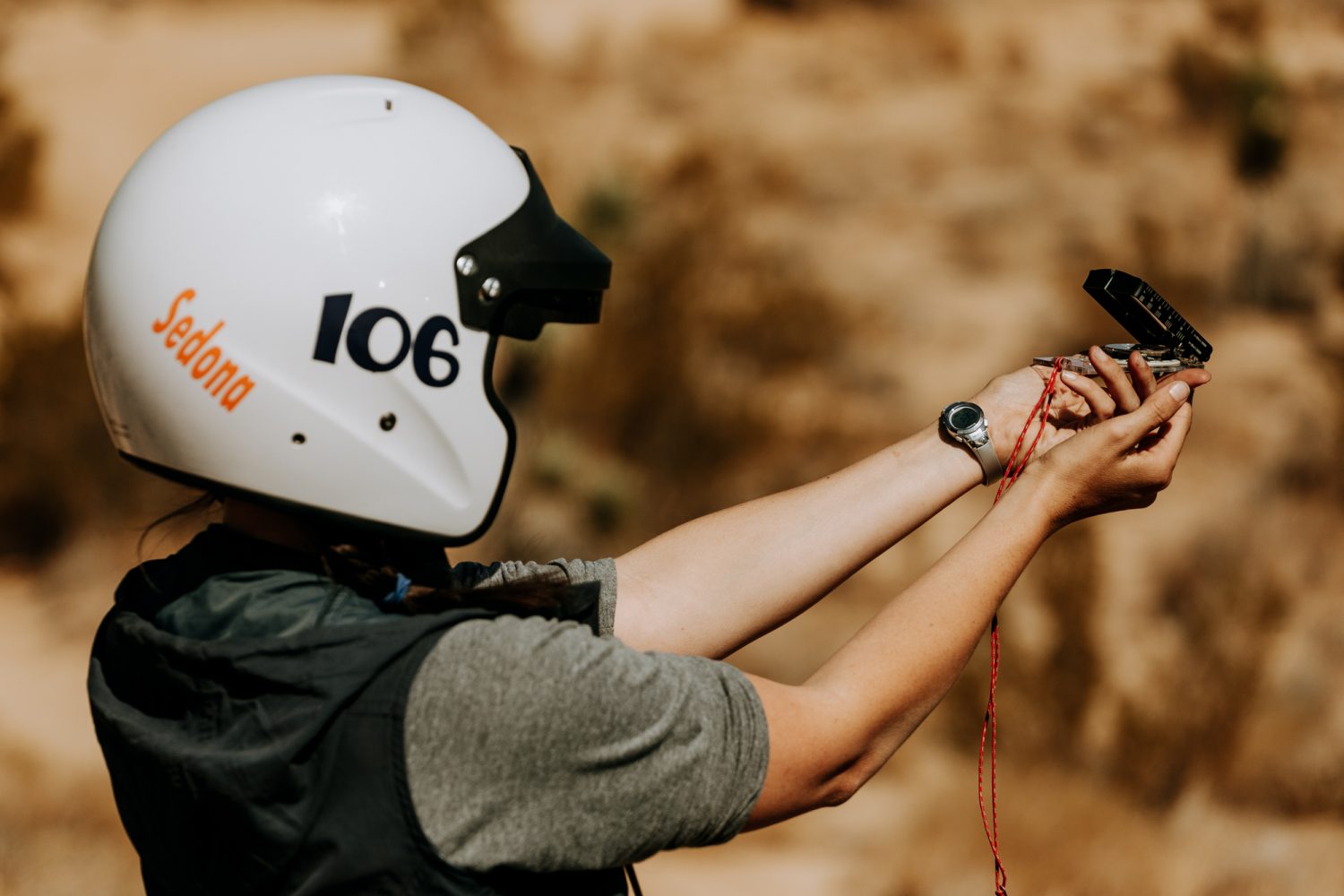
When Emily stopped suddenly—who knew why?—we kept going, until we encountered a small gathering of other confused competitors accumulating at a T-junction. Everyone was lost. “I couldn’t just lead you to camp, could I?” Emily said later. We didn’t know it, but we’d gone too far on a road that squiggled around like a 1980’s perm on our 1:200,000-scale map.
Hubris gushed through my veins. I saw the word “Meadow” half cropped off the edge of our map, allegedly where our camp was. I spotted a road sign that pointed east to French Meadow. “We’re supposed to be camping in a meadow. That’s it,” I said. And without a second look at our distance, we took off.
As the sun quickly dropped, we drove deep into Jawbone Canyon, a tree-canopied dirt road gutted by recent rainfall. French Meadow. Grouse Meadow. Weldon Meadow. Suddenly there were signs for a dozen meadows, and we had no clue which one we were supposed to look for. We kept driving, though every instinct said it didn’t look right. The event didn’t usually send teams over such sketchy terrain. Suddenly, the 33-inch Nitto Ridge Grappler tires and 3-inch lift on our rig felt extremely necessary. Sedona and I wandered deeper into the woods, like Hansel and Gretel in carbon helmets.
“Turn around,” Sedona finally said almost 25 minutes later. At least no birds had eaten our mental breadcrumbs. By the time we got back to the spot where everyone else had congregated, they were gone, no doubt having calmly and humbly pooled their brainpower and figured the way out. Panic rose in Sedona’s voice as she hinged her body at a perfect right angle over the map. “I have no idea where we are.” This was the first (and, thankfully only) time all week my steadfast teammate would utter these dreadful words.
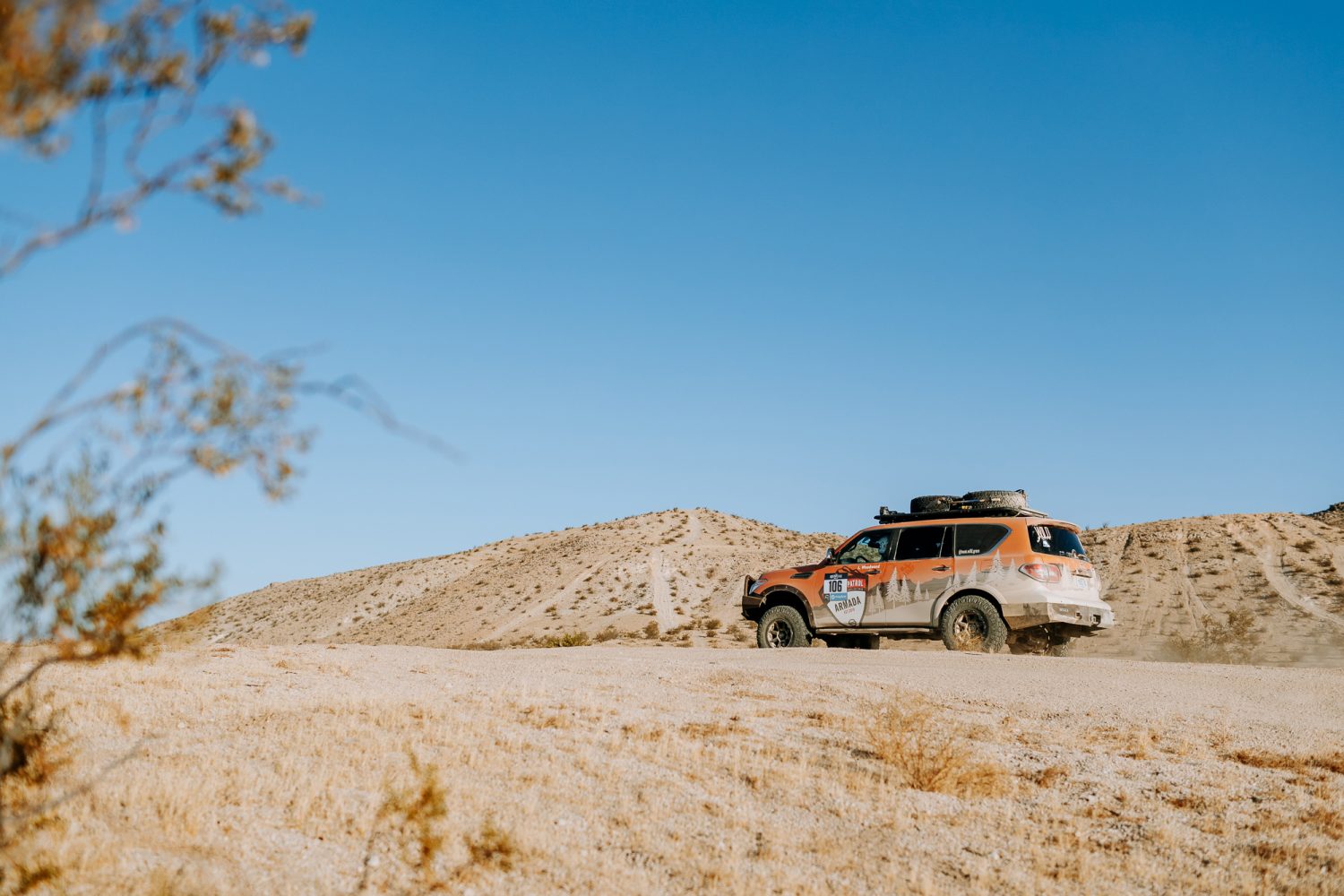
As the sun disappeared, my stomach churned with memories of my previous rally experience. Instead of thinking clearly, we started driving even farther away from where we were supposed to be. Devastated over our amateur-hour screwup, we pinged our tracker, giving us our location but also a 10-point penalty. We’d driven so far away that we were off our map—humiliation set in. I could only imagine what my dad was saying to his computer as he watched us drive around in circles on the live tracker. Your insecurities don’t care how far away you try to run. At least we were still in eighth place.

Day 5 CP 16 – Black | Johnson Valley OHV
34° 29.974’ N; -116° 47.980’ W
By day five, we’d settled into the bizarre Rebelle routine: Plot, drive, ping. Plot, drive, ping. Eat, sleep, repeat. Other Rebelle challenges include occasional time, speed, and distance trials, in which teams navigate using road books and must pass randomly positioned time controls for points. If you think driving fast around a racetrack causes duress, attempt driving under 15 mph for an hour and a half trying to pass unknown-until-you-see-them positions along the route within four seconds of your allocated time.
And as you start losing your mind in your new reality, no, you can’t call your therapist. Your phone is a prohibited item, stashed by the organizers under your passenger seat cocooned in evidence tape that tellingly disintegrates if you tamper with it. If for no other reason than this, picking your teammate on the Rebelle is paramount. Because even if you and your codriver’s goals are in sync, chaos ensues.
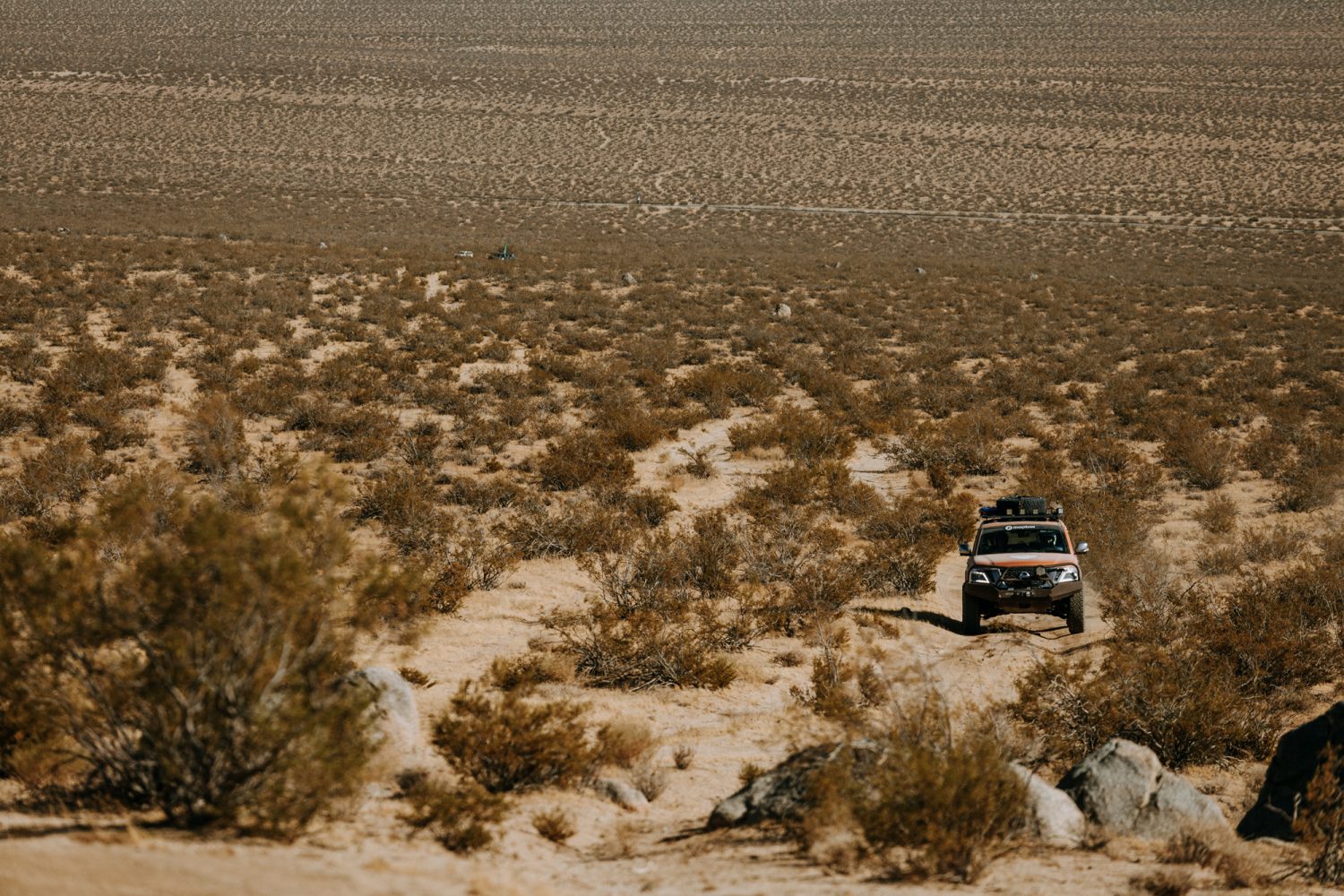
“Twenty minutes. I need 20 minutes to get us back to base camp,” I barked at Sedona as she lingered over the map trying to noodle out a black CP. She wasn’t positive we were in the correct spot and was anxious about the potential 10-point penalty you get for pinging your tracker in the wrong place. Losing another 10 for showing up late to base camp wasn’t happening on my watch, either, I reminded her.
Now we were running in seventh place, and mounting pressure oozed through the panel gaps in the Armada. Sedona outstretched her hands over the map, splaying her fingers in front of her with a sharp, downward gesture—her sign language for “Back off, Lyn.” The clock ticked off seconds faster than seemed natural, as if 100 could fit into a minute. We had to get going to Cougar Buttes, our next base camp. We could see it clearly from our current vantage point; the massive white event tent nestled in a rocky outcropping that popped up in the middle of California’s Johnson Valley state off-highway vehicle park.
“Do you trust me?” Sedona asked, ready to ping the tracker that would pinpoint our exact location on the planet within inches. At that moment, about that exact CP, if I’m being honest, the answer wasn’t yes.
But while I may not have had total confidence in that exact spot where she was about to ping, I trusted her implicitly. By day five, we’d earned that from each other. Where many competitors slashed tires crawling over jagged rocks, I drove smart and kept ours intact. She’d worked as diligently, triangulating to this checkpoint as every other, and always knew when she needed to cut bait instead of fishing for points because her pride wanted feeding. We had confidence in each other and articulated it often. “Go for it,” I said without hesitation. She leaped out, pinged, and barely got the seatbelt on before I took off toward base camp.
Feverishly, I tacked the Armada to starboard, then port, avoiding old rusted cans, dirt divots, and brittle desert holly. “Big hole,” I warned. Our keisters cleared the Armada’s seats while Sedona somehow plotted the digital coordinates that now glowed from our sat tracker. “This says we were on the other side of the mountain.” A series of expletives followed. But there was no time to fix mistakes now.
As calmly as I could, with enough adrenaline coursing through my body to power the Armada myself, I suggested she plot again. While I serpentined to the cluster of Mesozoic granite rocks we’d call home that evening, Sedona simmered beside me.


We arrived in base camp with four minutes to spare, and dinner cooked by a Michelin-starred chef awaiting (you do get some luxury for your money on the Rebelle). Eventually, Sedona looked up from the multiple new graphite highways she’d penciled onto our map, perplexed. “I don’t know what happened, but we’ll get some points. I guess we didn’t screw up.”
The Rebelle excels in exposing you, even if your problems are phantoms. But either way, she’d always get the yes from me. We succeeded together and made mistakes together. And when the scores posted, we were somehow still hanging on to seventh place, together.
Day 7 CP17X – Blue | Imperial Sand Dunes, Mexico/California Border
32° 54.342’ N; -115° 04.309’ W
When Sedona competed in the inaugural Rebelle Rally in 2016, she had almost zero experience before signing up. She loved the outdoors, had done some camping, and a little trail driving with her husband mostly behind the wheel and their two sons in back, but it wasn’t much fun until she got in the driver’s seat. That first year, she reached out to Nissan to sponsor a truck, and they did. Other manufacturers such as Jeep, Ford, Mitsubishi, Lexus, Honda, and even Rolls-Royce have entered vehicles, making the Rebelle something of an auto industry testbed.
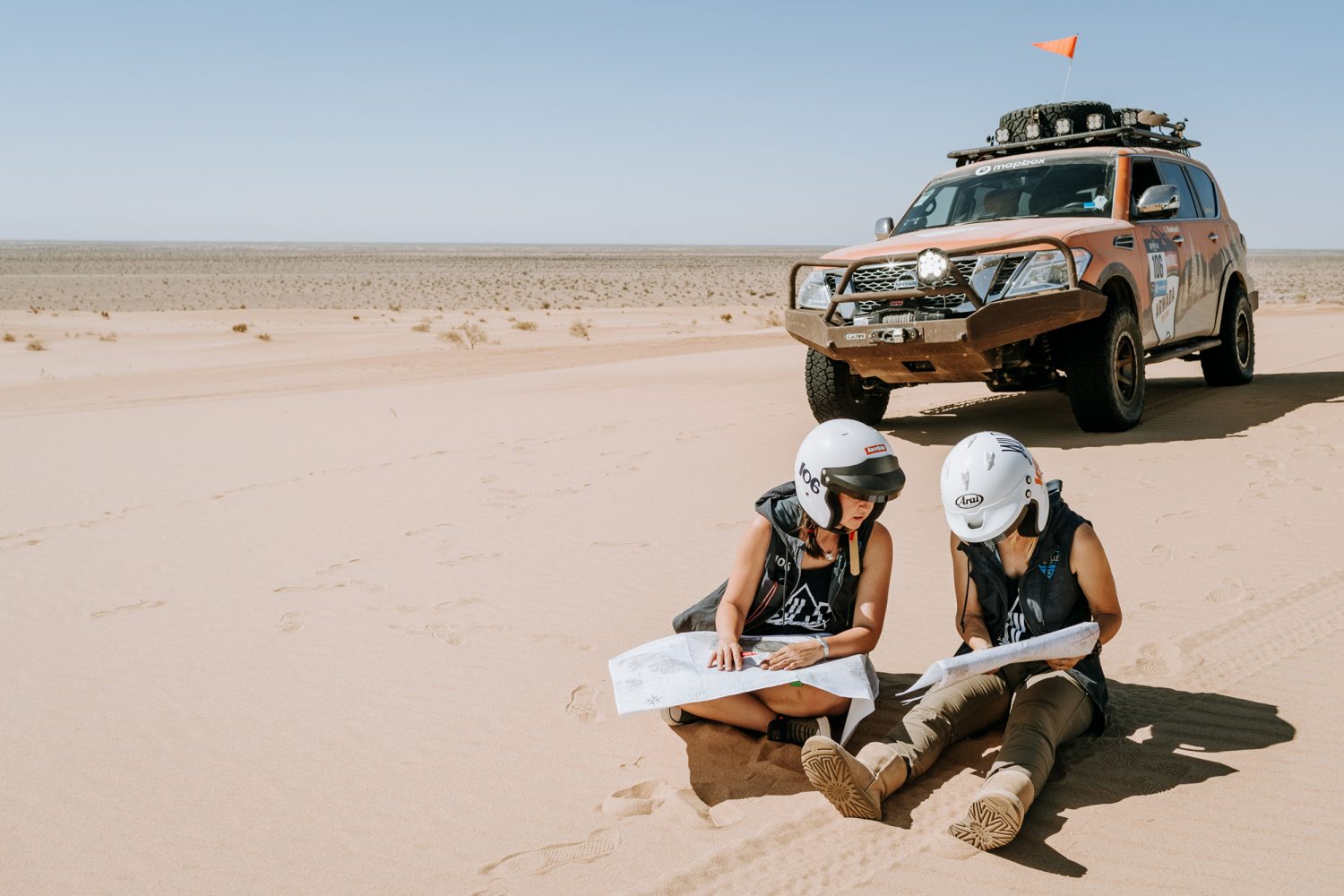
Four years and seven days later, again supported by Nissan with our Armada, Sedona and I found ourselves on what looked like the set of Lawrence of Arabia. Latte-colored dunes stretched before us, blown by the wind into a fearsome ocean of sandy dread. Glamis, as these dunes are known locally, is where the Rebelle Rally is won or lost. Sedona wielded no confidence navigating the ever-shifting mountains, and I harbored only abject terror of being sucked down by them. For Wild Grace, this would be where we chased our validation and redemption.
During our morning briefing, Emily pointed out the CPs on our daily list that were marked with an asterisk, meaning they were hard. “Technical dune driving required, do not drive above your skill level,” she warned, calling out the CPs numbered 17, 18, and 19 in particular. “We don’t need to go for those if we don’t want to,” Sedona said. “Right, we don’t have anything to prove,” I replied, conjuring a mental picture of our Armada capsized on its roof. I wanted to believe the words I had just said, but the truth bubbled just below my nonchalance. I wanted to go for it, but I wasn’t sure I had the skill to beat the sand—or the balls.
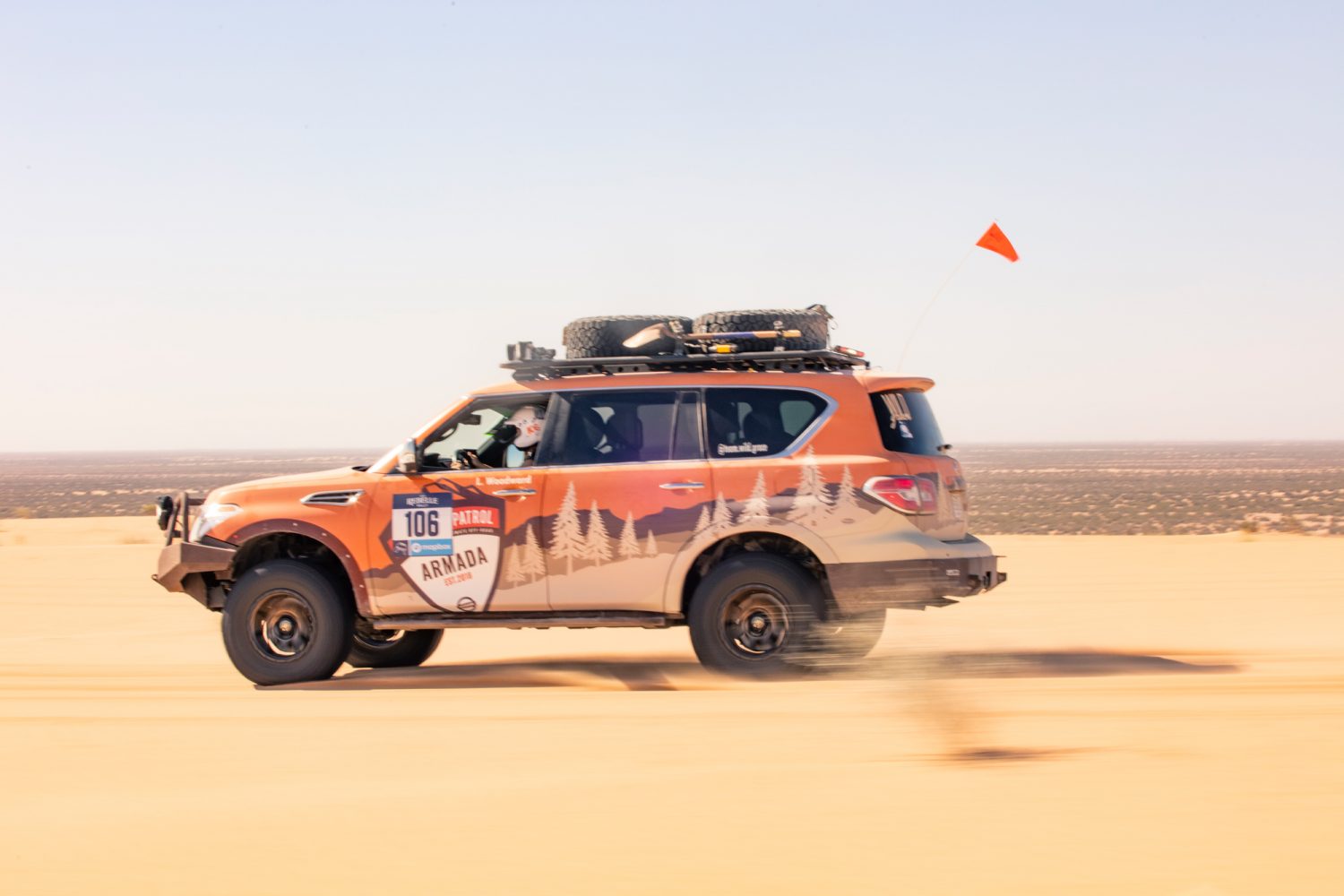
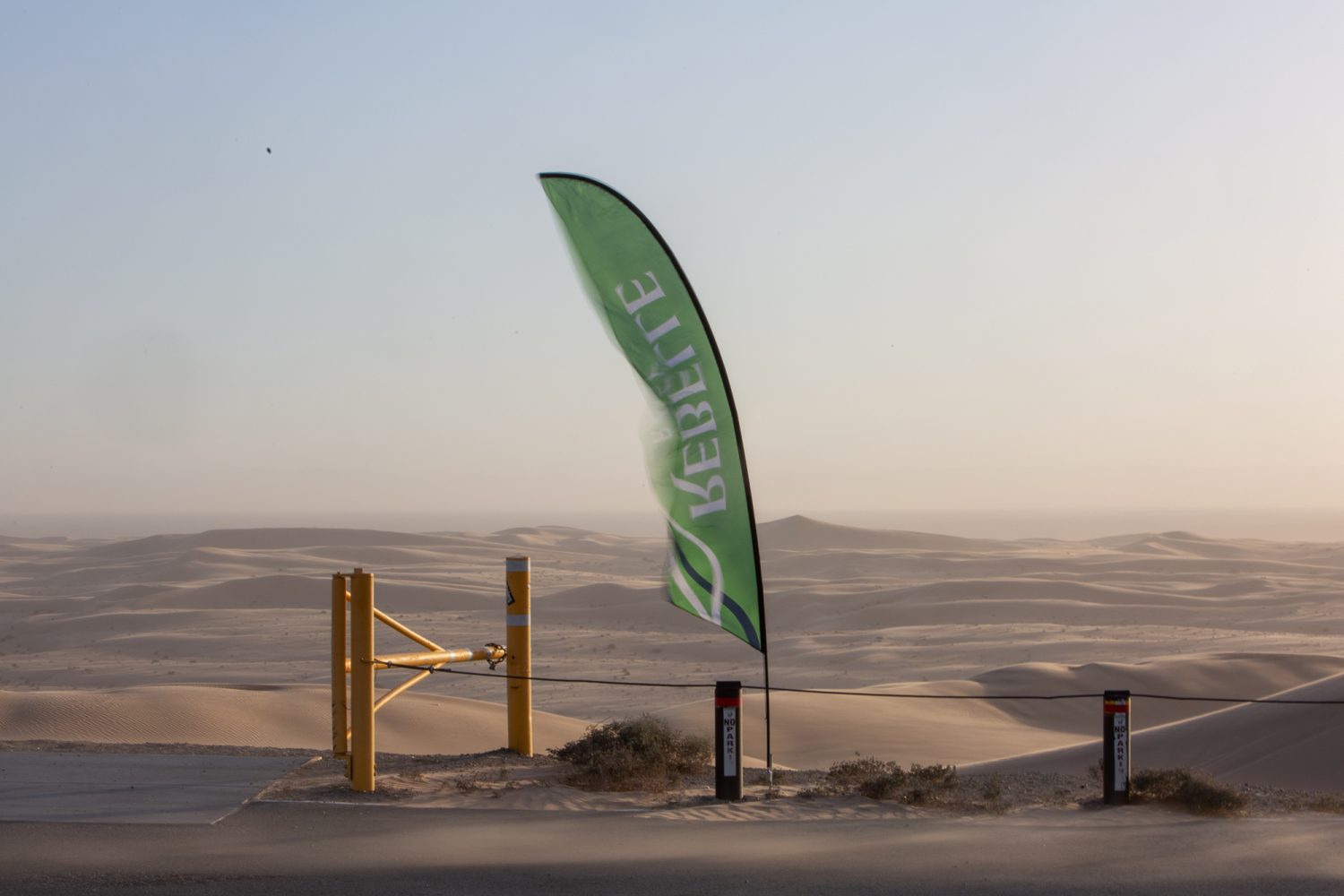
As the sun climbed higher, we snagged CP after CP. The Armada, with its tires aired down to a scant 15 psi, felt like a hovercraft over the sand. Sedona’s Spidey Sense for the terrain grew exponentially in this overgrown litter box. “It’s over there, I know it,” she would say. And it was. Our momentum built with every correct tracker click. After our week together, the Armada and I were one now. My foot whispered to it through the throttle, and it responded back, authoritative and confident. Our moves felt as choreographed as Argentine tango.
Parked on the edge of a sand cliff, staring into miles of jutting beige peaks, we pinged at CP 16. The moment had come to either go all-in or cut. “If you don’t feel comfortable, I know I can get us out,” Sedona said emphatically. That was all I needed. Like everything else this week, we’d jump together. I pointed the Armada’s wheels downward, and we flowed over the steep dune like a waterfall straight into our fear.
Encouraged to pair up with other teams for safety reasons, we did. With Team #154 (Roads Less Traveled) and Team #123 (Rogue Wave), we took Glamis dune by dune, scouting first on foot, and then riding each slope like seasoned skiers. Save for a bitchin’ four-wheels-off Robby Gordon moment for Roads Less Traveled, there were few theatrics. No need for recovery gear. I’d pick my lines, take a patient breath, then control the Armada to my will.

“I’ve never been out this far,” Sedona said. We were giddy, sitting beside each other on Glamis’s legendary swing set, a memorial with actual swings built deep in the shifty mountain range in honor of a duner who’d lost his battle with cancer. “I’ve always wanted to see this,” she added. This was a spot mostly frequented by seasoned sand vets piloting their irksome and unstoppable side-by-sides. Yet here were a preschool teacher and a writer—hard workers, but both of whom had only started navigating and off-roading on occasion four years earlier—in an over-6,000-pound mom mobile playing in the sandbox with the big girls. And holding their own.
Crossing the finish line later felt like the lid releasing on a pressure cooker. Is it possible to be both numb and exhilarated at the same time? Yes, it is. Thanks to our dumbfounding fourth-place finish for the day in Glamis, Sedona and I would rise up the ranks to take a slap-us-and-wake-us-up sixth place overall in the 4WD class. As in any good story, when it’s over, my character came out the other end utterly changed, redeemed. No screaming required.
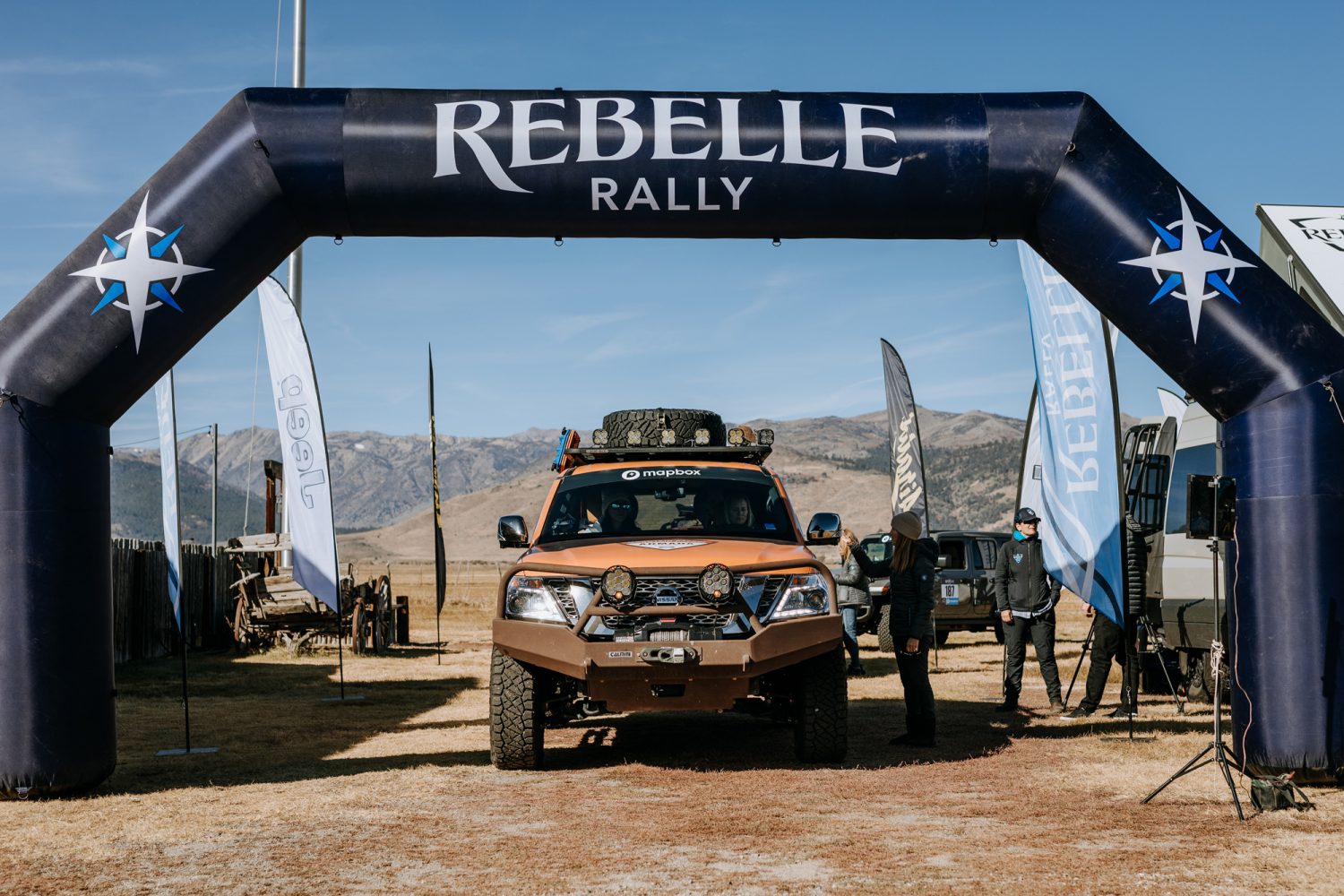
Day 8 – Rebellation | Sheraton San Diego Hotel and Marina
32° 43.6284 N; -117° 11.8824 W
Over seven days, 38 teams comprised of 76 women tackled 145 checkpoints over 1,500 miles using zero GPS. The day after the rally ended, we drove to San Diego for the final celebration. Sedona and I walked out of our hotel blessedly showered, shaved, and not smelling like the previous Tuesday’s leftover ham sandwich. A blonde with a Texas-style mane of hair stopped me when she saw my Rebelle competitor’s vest. “Oh, my gosh,” she said, “I’ve been following you ladies. I want to do the Rebelle so badly, but my husband won’t let me take the Jeep because I don’t know how to fix it.”
We assured her she didn’t need to know how to fix a vehicle. The Rebelle has mechanics and even fellow competitors who will help you on the course. She just had to be willing to learn some basic new skills and have a life-changing experience. She sheepishly shook her head no. “I’ll keep following you, though. It’s so awesome you did that.”
I thought of something Emily Miller repeats to competitors often. “If it were easy, everyone would do it.” We all have our roadblocks.
Sedona and I looked at each other and smiled. Words felt unnecessary. The funny thing about spending a week in an empty wilderness with nothing to rely on but a compass and a paper map and the person sitting next to you is that you come to feel less lost than you ever were in your life.
Visit rebellerally.com for details.


